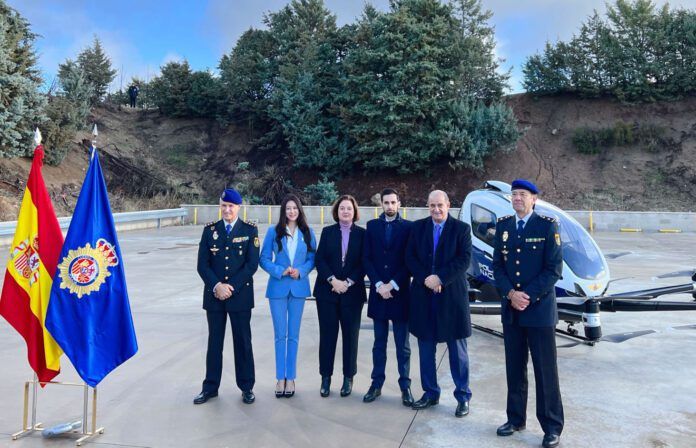The Spanish National Police (SNP) have officially started trial operations with the Ehang EH216 autonomous electric vertical take-off and landing (eVTOL) vehicle. SNP and China-based autonomous aerial vehicle (AAV) company EHang announced the collaboration in October 2021, stating that they would be exploring how to best use AAV technology in emergency and security missions through trial flights and use case analysis. The EH216 is being considered for tasks such as “accessing contaminated areas with nuclear, radiological, bacteriological or chemical risks, landing in confined areas, aerial logistics, and other police services.”
“The SNP is the first security institution in the European Union to operate an AAV,” said Spain’s Secretary of State for Security Rafael Pérez. “Unmanned aircraft systems (UAS) constitute an alternative technological asset for multiple purposes, such as deployment in dangerous areas following a natural disaster or an accident, without endangering human lives. The lower operating costs of UAS and their constant new applications show great advantages over traditional aerial means.”
Ehang’s EH216 AAV has reportedly completed more than 30,000 test flights with its first public passenger flights taking place in Vienna, Austria, in April 2019. The aircraft has a range of 30 km (16 NM), top speed of 130 km/h (70 knots) and payload capacity of 220 kg (485 pounds). As previously reported by AVweb, the Civil Aviation Administration of China (CAAC) established a type certification team for the EH216 in April 2021 and certification activities are ongoing.



































Have any of the eVTOL doubters who frequent this site begun to question their sentiments yet ?
According to Spain’s Security Secretary words, they will keep it unmanned. Reassuring, right?
Very much so. Pilots kill a lot of people. (I’m a pilot BTW.)
We had a police autogyro at our busy airport. I used to feel sorry for the 2 bobble-head officers trying to get out of the pattern and trudge off at 40kts to do “police work”. That lasted about 6 months and then they parked it in their hangar and switched back to conventional helicopters.
I only question how long (after the ceremonies and congratulations) that this little contrivance will also be parked somewhere in a hangar. Of course, no one will report of the failure.
Comparing autogyros to helicopters is like comparing apples to cumquats. Did they park the gyro because it was dysfunctional, or because it was being assigned to the wrong missions? Sounds to me like a failure in their needs analysis, not a failure of the aircraft.
The comparison to REAL helicopters is the same with eVTOL. eVTOL and autogyros cannot replace powerful capable well developed helicopter platforms being used in that role.
I bet the Ukrainians could figure out a good use for this. Just think how many mortar shells it would carry.
Conventional helicopters have autorotation capabilities in case of engine failure, saving many. With e-vtols, are there life limits on e-motors, batteries, systems, blades? My guess is autorotation capability doesn’t exist, presenting a whole new paradigm.
A ballistic parachute, maybe? Oh, wait, there goes 40 pounds of payload.
Of course there will be life limits – what makes you think there wouldn’t be?
And people besides you have actually thought about motor failure. https://www.aopa.org/news-and-media/all-news/2019/april/26/this-failsafe-can-save-the-day-if-your-drone-loses-a-motor
That’s for a quad, the EH216 has 8 motors, making the loss of a motor an even easier problem to cope with.
E-VTOLS
E-VTOLS typically rely on redundancy rather than autorotation. Redundancy can be a better (as in survivable) solution at lower altitude/airspeed combinations – notably, when taking off or landing.
This proposed use may be one of the very few examples that might make sense for EVtols. This assumes that airspace and other regulations can be met. But this very limited use of a very limited range vehicle does not change the deserved skepticism for the whole EVtol practicality issue.
There was an airplane that first flew 119 years ago for 12 seconds and 120 feet. By the end of the day it flew 852 feet and for 59 seconds. It’s a good thing the two brothers didn’t pay any attention to be like you.
… to *people* like you.
Ah, you coulda been a tad nicer with your reply.
After 119 years of testing, powered flight has proven to be done best with liquid fuel. If you listen to history then you’ll already know that batteries were never a first (nor even second) choice. If you listen to NPR then you don’t let history get in the way of your utopian dream.
119 years of testing is the past, let’s see what can be done with the energy storage constraints. We don’t know what we don’t know
Actually, development of new energy storage is best done on the ground in cars. Otherwise there are so many variables of weight, heat, wiring, etc that doing it on a flying system will actually SLOW development.
Normally, first you manage to improve your distance and endurance 8X in a day, second you invite the press and third you build airports.
10+ years of daily press releases and cutting ribbons at vertiports in advance is not helping the advance in engineering. On the contrary – it makes the already huge waste only bigger, and limits funding to projects promising realistic benefits.